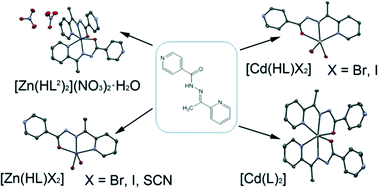Synthesis, X-ray characterization, DFT calculations and Hirshfeld surface analysis of Zn(ii) and Cd(ii) complexes based on isonicotinoylhydrazone ligand†
Abstract
In this manuscript we report the synthesis and X-ray characterization of four Zn(II) complexes and three Cd(II) complexes with an asymmetrical hydrazone–pyridine based ligand {HL = 2-acetyl-pyridyl-isonicotinoylhydrazone (HAPIH)}; i.e. {[Zn(HL)2](NO3)2·H2O} (1), [Zn(HL)Br2] (2), [Zn(HL)I2] (3), [Zn(HL)(NCS)2] (4), [Cd(L)2] (5), {[Cd(HL)Br2]·CH3OH} (6) and {[Cd(HL)I2]·2CH3OH} (7). The Schiff base acts as a tridentate N2O-donor ligand through the oxygen, the imine and pyridine nitrogen atoms in all the complexes. In most complexes, the ligand is observed to coordinate as a zwitterion since the proton in the hydrazine group (![[double bond, length as m-dash]](https://www.rsc.org/images/entities/char_e001.gif) N–NH–C
N–NH–C![[double bond, length as m-dash]](https://www.rsc.org/images/entities/char_e001.gif) O) shifted to the uncoordinated pyridine ring, except in 7. On the other hand, in 5 the ligand acts as a negatively charged species and is bound to the cadmium center in the enolic form (
O) shifted to the uncoordinated pyridine ring, except in 7. On the other hand, in 5 the ligand acts as a negatively charged species and is bound to the cadmium center in the enolic form (![[double bond, length as m-dash]](https://www.rsc.org/images/entities/char_e001.gif) N–N
N–N![[double bond, length as m-dash]](https://www.rsc.org/images/entities/char_e001.gif) C–O−). In complexes 2–4, 6 and 7, the coordination geometry around each metal center is distorted trigonal bipyramidal, with the coordination sphere of the metal completed by two halide or NCS anions. On the other hand, in homoleptic complexes 1 and 5, the metal, chelated by two tridentate Schiff base ligands, exhibits an octahedral geometry. In the crystal packing of all compounds, the pyridine rings favour π–π interactions among the symmetry related complexes. The noncovalent interactions among the complexes have been analyzed using Hirshfeld surface analysis and DFT calculations using Grimme's D3 dispersion correction to properly describe the π–π interactions.
C–O−). In complexes 2–4, 6 and 7, the coordination geometry around each metal center is distorted trigonal bipyramidal, with the coordination sphere of the metal completed by two halide or NCS anions. On the other hand, in homoleptic complexes 1 and 5, the metal, chelated by two tridentate Schiff base ligands, exhibits an octahedral geometry. In the crystal packing of all compounds, the pyridine rings favour π–π interactions among the symmetry related complexes. The noncovalent interactions among the complexes have been analyzed using Hirshfeld surface analysis and DFT calculations using Grimme's D3 dispersion correction to properly describe the π–π interactions.



 Please wait while we load your content...
Please wait while we load your content...